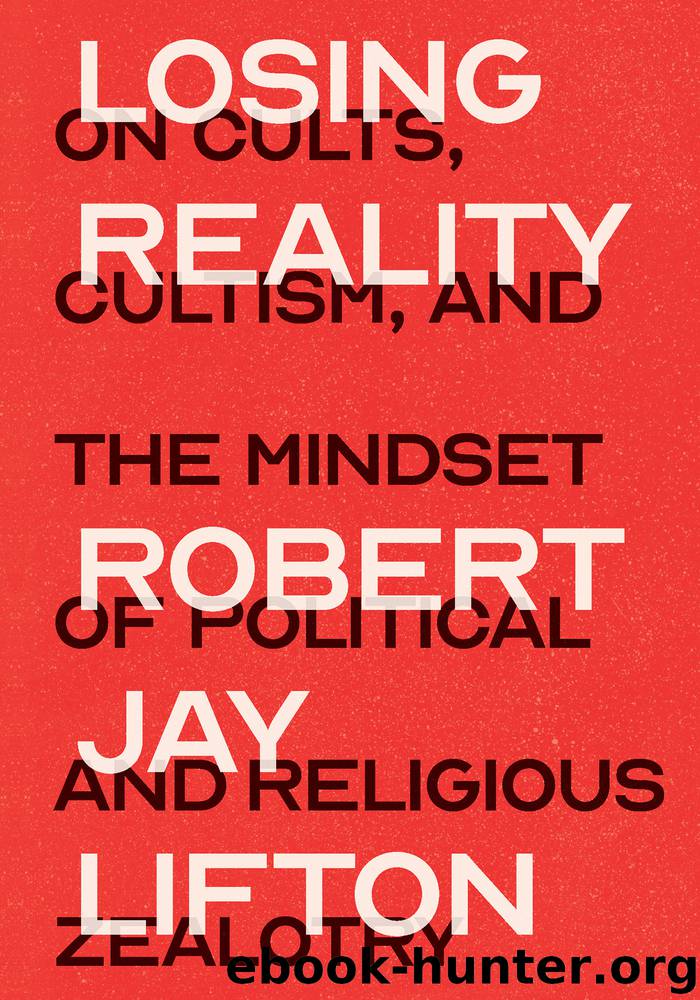Losing Reality by Robert Jay Lifton

Author:Robert Jay Lifton
Language: eng
Format: epub
Publisher: The New Press
Published: 2019-03-17T16:00:00+00:00
Part Two
World-Ending Threats
5
Aum Shinrikyō
In combining ultimate fanaticism with ultimate weapons, Aum Shinrikyō (1984–95) was a new and highly dangerous manifestation of cultism. Like many other cults and political movements, Aum was apocalyptic. Its apocalypticism was not only fierce but activist. Aum’s guru, Shōkō Asahara, impressed on his followers the responsibility of joining in the military struggle that would bring on Armageddon and provide a means for the surviving remnant to take the lead in creating a purified world. Aum created a cultic project of destroying the world.
That was of course the most grandiose of missions, and Aum did not end up making much of a contribution to it. But Aum’s scientists did succeed in producing and releasing very crude versions of chemical and biological weapons and sought unsuccessfully to acquire nuclear weapons as well. In its embrace of weapons of mass destruction, Aum was translating its nuclearized apocalyptic vision into actual steps taken in the real world.
Given his world-ending proclivities, we should not be surprised that Asahara strongly admired two of the twentieth century’s greatest annihilators of their fellow human beings, Adolf Hitler and Mao Zedong.
Significantly, Asahara was obsessed with Hiroshima and its suggestion of world destruction. In what he called his “meditations,” he described his “astral body” separating from his physical body and arriving in a devastated Hiroshima populated by moribund survivors consumed by radiation effects. He alone could transcend these effects and render Hiroshima an important part of his world-ending story.
Apocalyptic activism has a very long history. According to Gershom Scholem, a leading authority on Jewish mysticism, the practice was known to ancient rabbis as “forcing the end.” At issue was a moral question: given the inevitability of violence prior to the appearance of the messiah, should one join in that violence to hasten the messianic moment? The rabbis, in their wisdom, decided that “forcing the end” in that way would be an expression of undesirable “impatience” and that only God could set a messianic timetable. Aum Shinrikyō demonstrated that contemporary cultists need feel no such restraint.
Apocalyptic narratives are always about survival, and in this one only Asahara and his closest disciples would be among the surviving remnant. The nuclear holocaust in his view would be a form of karmic “cleansing,” and he and his disciples would find food free of radioactive contamination. But on the matter of survival, there is another important point to note. Aum disciples had no standing other than their merging with the guru, absorbing him, becoming part of him, or in their own parlance, becoming “clones” of Asahara. And since only those whose merger with the guru was most complete would survive, the guru himself would be the lone survivor, would be what has been described in the literature on paranoid grandiosity as “the last man to remain alive.”
To understand the reach of cultism, it is useful to briefly compare Aum Shinrikyō with ISIS in terms of our perceptions of the two groups. We think of Aum Shinrikyō primarily as a fanatical religious cult with a fierce measure of apocalypticism.
Download
This site does not store any files on its server. We only index and link to content provided by other sites. Please contact the content providers to delete copyright contents if any and email us, we'll remove relevant links or contents immediately.
Periodization Training for Sports by Tudor Bompa(8217)
Why We Sleep: Unlocking the Power of Sleep and Dreams by Matthew Walker(6659)
Paper Towns by Green John(5141)
The Immortal Life of Henrietta Lacks by Rebecca Skloot(4552)
The Sports Rules Book by Human Kinetics(4348)
Dynamic Alignment Through Imagery by Eric Franklin(4179)
ACSM's Complete Guide to Fitness & Health by ACSM(4021)
Kaplan MCAT Organic Chemistry Review: Created for MCAT 2015 (Kaplan Test Prep) by Kaplan(3972)
Introduction to Kinesiology by Shirl J. Hoffman(3744)
Livewired by David Eagleman(3730)
The Death of the Heart by Elizabeth Bowen(3581)
The River of Consciousness by Oliver Sacks(3574)
Alchemy and Alchemists by C. J. S. Thompson(3484)
Bad Pharma by Ben Goldacre(3398)
Descartes' Error by Antonio Damasio(3250)
The Emperor of All Maladies: A Biography of Cancer by Siddhartha Mukherjee(3114)
The Gene: An Intimate History by Siddhartha Mukherjee(3076)
The Fate of Rome: Climate, Disease, and the End of an Empire (The Princeton History of the Ancient World) by Kyle Harper(3035)
Kaplan MCAT Behavioral Sciences Review: Created for MCAT 2015 (Kaplan Test Prep) by Kaplan(2960)
